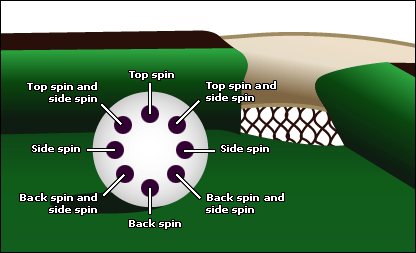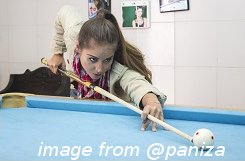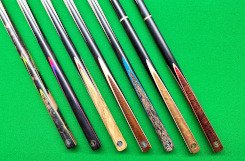Applying spin to the cue ball
If you strike the cue ball at 12 o’clock i.e. above the centre spot top spin will be given to the cue ball, striking the cue ball at 6 o’clock will give you bottom spin, and of course 9 o’clock and 3 o’clock will provide you with side spin. Of course striking the cue ball between these positions will give you a greater variation but this will be discussed later in this article.
You should also remember that the power you apply to the shot will affect the amount of spin you manage to achieve hence the need to practice so that you can strike the ball confidently and get the right result. The next sections below will describe the different spins and the effect that they will have on the cue ball.
Top spin
Top spin occurs when you apply the cue tip above the centre spot of the cue ball. The higher the strike the more top spin that is applied. You may sometimes hear top spin referred to as “follow” this is due to the fact that the cue ball will follow through after striking the object ball.The mechanics of this works as you are applying more forward spin that with a straight shot thus causing the cue ball to travel further along the pool cloth after the shot rather than slowing down immediately. Applying top spin will also affect the angle that the cue ball takes after striking a cushion or object ball, often widening the angle of departure. Quite often with some top spin shots you may see the cue ball seem to stop before starting to move forward again, a useful shot for exhibition events etc. once mastered. This hot is also useful if there is a risk of the cue ball resting behind a ball or balls that may prevent you from taking a clear shot onto your next object ball.
Bottom spin
As expected bottom spin occurs when the cue ball is struck below the centre point and as with top spin but in reverse, the lower you strike the ball the more bottom spin is applied. This shot is sometimes referred to as a “screw” or “draw” shot as you are drawing the ball away from its natural settling point on the cloth after the shot has been played. If the cue ball has been struck correctly with just enough bottom you can also create a stun shot where the ball will stop immediately after striking the object ball, a great positional shot. The complete opposite to top spin occurs when the cue ball strikes the object ball or cushion with regards to the angle of departure. If played correctly it will slightly reduce this angle.
Side spin
Side spin is used to affect the angle of departure from the cushion or the object ball by the cue ball after the shot has been played. This shot is sometimes referred to as “English” in some countries or just left or right spin. This type of spin is created by striking the cue ball to the left or right of the centre spot dependant on which spin you wish to apply. This is commonly used for positional shots but unless mastered and the shot played perfectly it can lead to some potting errors or the cue ball not quite finishing movement where expected.
The three shots mentioned above are the three basic spin shots that are used in the game of billiards, snooker or pool. Of course there are variations to these shots sometimes unintentional if the cue tip has not struck true on the cue ball. The spins can be merged for different effects on the shot i.e. it you strike the cue ball midway between the above centre and side centre you will get a combination of both top and side spin. This is the reverse effect if you strike the cue ball between the bottom and side of the cue ball thus giving you a much wider range of shots to play for different situations.
As you can see practice really is important to perfect these shots and see the effect that they have on the cue ball. With experience and more match play you will soon begin to recognise when certain spin shots should be played during the game, using the incorrect spin can mean the end of your visit or at the least making your next shot a lot more difficult if the cue ball does not rest where you wanted it to.
You should also remember that different tables can affect how the spin performs on the cue ball as different cloths can produce less or more spin dependant on the friction that the cloth itself applies. The quality or hardness of the cushions will also affect the resultant shot that is played. It is always advised to try to get some practice shots on the table that you are playing so that you can counteract any effect the table has on the cue ball.


